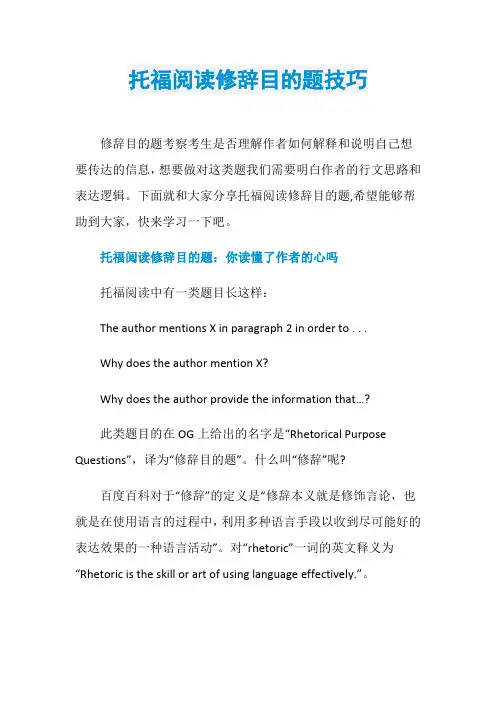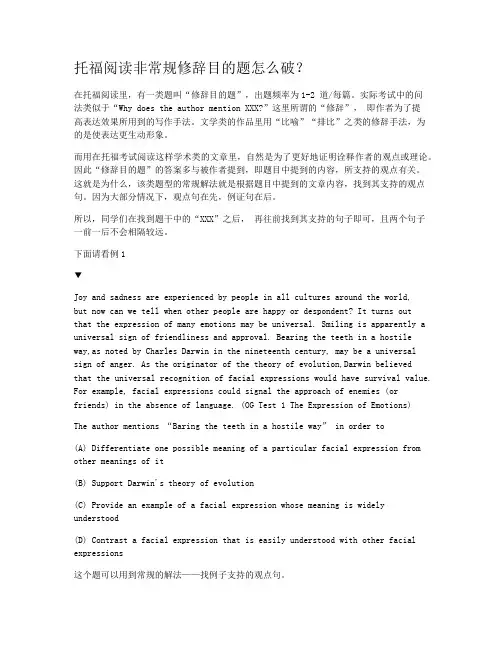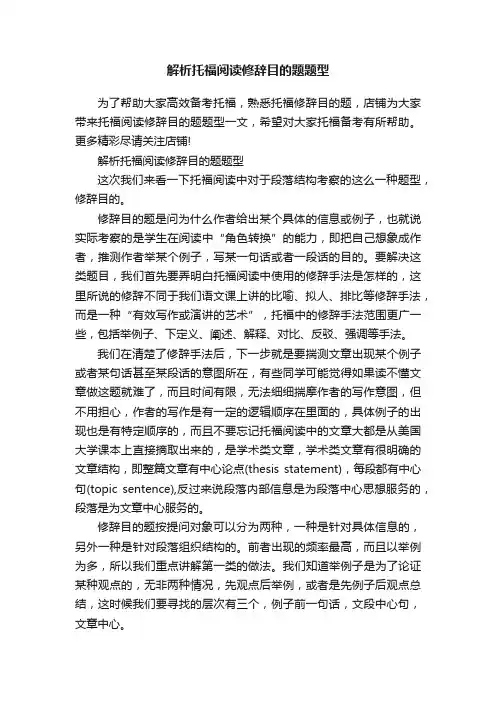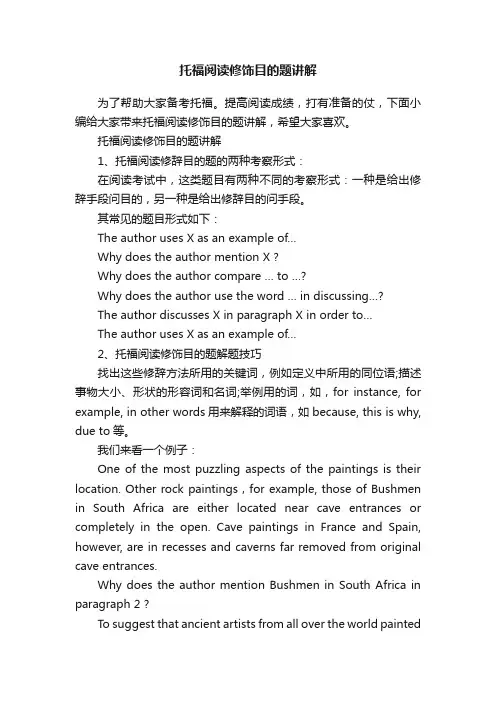托福阅读之修辞目的题的解题思路与技巧
- 格式:pptx
- 大小:1.53 MB
- 文档页数:22


2个实例详解托福阅读修辞目的题从题干找线索解题技巧托福阅读中既有不需要思考太多直接就能从原文找到答案的题目,也有需要考生自己主动思考分析才能得出结论的题目。
今天小编给大家带来了2个实例详解托福阅读修辞目的题从题干找线索解题技巧希望能够帮助到大家,下面小编就和大家分享,来欣赏一下吧。
2个实例详解托福阅读修辞目的题从题干找线索解题技巧托福阅读修辞目的题出题形式简介托福阅读修辞目的题的格式是这个样子的:“why does author mention ”注意这里的why不是定位文中的because来找答案,而是应采取这样一种思维即:题干作为一个细节,其存在的价值是为了支撑前面出现的观点,所以答案在题干细节出现的位置前面去找,也就是找到观点 (注意避开其他同样支撑观点的细节)修辞目的题解题思路实例分析实例1:Paragraph 6: But neither the human imitativeinstinct nor a penchant for fantasy by itself leads to an autonomous theater.Therefore, additional explanations are needed. One necessary condition seems tobe a somewhat detached view of human problems. For example, one sign of thiscondition is the appearance of the comic vision, since comedy requires sufficientdetachment to view some deviations from social norms as ridiculous rather thanas serious threats to the welfare of the entire group. Another condition thatcontributes to the development of autonomous theater is the emergence of theaesthetic sense.2. Why does the author mention “comedy”?A. To give an example of early types of theater.B. To explain how theater helps a society respond to threats to its welfare.C. To help explain why detachment is needed for the development of theater.D. To show how theatrical performers become detached from other members of society.本题中的comedy虽为一个小词,看似不起眼,但是它所存在的句子,句首为for example,这就构成了明显的举例关系,所以答案还是在前面找这个例子所证明的观点。

托福阅读修辞目的题技巧修辞目的题考察考生是否理解作者如何解释和说明自己想要传达的信息,想要做对这类题我们需要明白作者的行文思路和表达逻辑。
下面就和大家分享托福阅读修辞目的题,希望能够帮助到大家,快来学习一下吧。
托福阅读修辞目的题:你读懂了作者的心吗托福阅读中有一类题目长这样:The author mentions X in paragraph 2 in order to . . .Why does the author mention X?Why does the author provide the information that…?此类题目的在OG上给出的名字是“Rhetorical Purpose Questions”,译为“修辞目的题”。
什么叫“修辞”呢?百度百科对于“修辞”的定义是“修辞本义就是修饰言论,也就是在使用语言的过程中,利用多种语言手段以收到尽可能好的表达效果的一种语言活动”。
对“rhetoric”一词的英文释义为“Rhetoric is the skill or art of using language effectively.”。
结合“修辞”的解释和题目所问内容“为什么作者…”,我们很容易理解所谓author的“目的”,只不过就是“试图更清楚的解释和说明作者自己想要传达的信息”。
搞清楚这点就会更容易解答这类题目。
作者大大们是如何实现这个目的的?# 1 举例论证或解释(最常出现)“举个例子”是在说理的过程中最常见的一种方式。
一般情况下,叙述者在给出一个“观点”后,往往会搭配一个具体的实例来支持这个观点。
又或者原文出现某个“理论”后,紧跟着出现一个已经发生的实例来进一步印证这个理论的可靠性。
还会出现的情况是,原文引入了一个学术名词,通过举一些我们熟悉的例子,来辅助解释这个名词。
当然,在少数情况下,叙述者也可能先给出一个具体的实例,然后引出结论。
有些题目会出现比较明显的表示举例的词组,如for example、for instance等。



托福阅读非常规修辞目的题怎么破?在托福阅读里,有一类题叫“修辞目的题”,出题频率为1-2 道/每篇。
实际考试中的问法类似于“Why does the author mention XXX?”这里所谓的“修辞”,即作者为了提高表达效果所用到的写作手法。
文学类的作品里用“比喻”“排比”之类的修辞手法,为的是使表达更生动形象。
而用在托福考试阅读这样学术类的文章里,自然是为了更好地证明诠释作者的观点或理论。
因此“修辞目的题”的答案多与被作者提到,即题目中提到的内容,所支持的观点有关。
这就是为什么,该类题型的常规解法就是根据题目中提到的文章内容,找到其支持的观点句。
因为大部分情况下,观点句在先,例证句在后。
所以,同学们在找到题干中的“XXX”之后,再往前找到其支持的句子即可,且两个句子一前一后不会相隔较远。
下面请看例1▼Joy and sadness are experienced by people in all cultures around the world,but now can we tell when other people are happy or despondent? It turns outthat the expression of many emotions may be universal. Smiling is apparently a universal sign of friendliness and approval. Bearing the teeth in a hostile way,as noted by Charles Darwin in the nineteenth century, may be a universal sign of anger. As the originator of the theory of evolution,Darwin believedthat the universal recognition of facial expressions would have survival value. For example, facial expressions could signal the approach of enemies (or friends) in the absence of language. (OG Test 1 The Expression of Emotions)The author mentions “Baring the teeth in a hostile way” in order to(A) Differentiate one possible meaning of a particular facial expression from other meanings of it(B) Support Darwin's theory of evolution(C) Provide an example of a facial expression whose meaning is widely understood(D) Contrast a facial expression that is easily understood with other facial expressions这个题可以用到常规的解法——找例子支持的观点句。

解析托福阅读修辞目的题题型为了帮助大家高效备考托福,熟悉托福修辞目的题,店铺为大家带来托福阅读修辞目的题题型一文,希望对大家托福备考有所帮助。
更多精彩尽请关注店铺!解析托福阅读修辞目的题题型这次我们来看一下托福阅读中对于段落结构考察的这么一种题型,修辞目的。
修辞目的题是问为什么作者给出某个具体的信息或例子,也就说实际考察的是学生在阅读中“角色转换”的能力,即把自己想象成作者,推测作者举某个例子,写某一句话或者一段话的目的。
要解决这类题目,我们首先要弄明白托福阅读中使用的修辞手法是怎样的,这里所说的修辞不同于我们语文课上讲的比喻、拟人、排比等修辞手法,而是一种“有效写作或演讲的艺术”,托福中的修辞手法范围更广一些,包括举例子、下定义、阐述、解释、对比、反驳、强调等手法。
我们在清楚了修辞手法后,下一步就是要揣测文章出现某个例子或者某句话甚至某段话的意图所在,有些同学可能觉得如果读不懂文章做这题就难了,而且时间有限,无法细细揣摩作者的写作意图,但不用担心,作者的写作是有一定的逻辑顺序在里面的,具体例子的出现也是有特定顺序的,而且不要忘记托福阅读中的文章大都是从美国大学课本上直接摘取出来的,是学术类文章,学术类文章有很明确的文章结构,即整篇文章有中心论点(thesis statement),每段都有中心句(topic sentence),反过来说段落内部信息是为段落中心思想服务的,段落是为文章中心服务的。
修辞目的题按提问对象可以分为两种,一种是针对具体信息的,另外一种是针对段落组织结构的。
前者出现的频率最高,而且以举例为多,所以我们重点讲解第一类的做法。
我们知道举例子是为了论证某种观点的,无非两种情况,先观点后举例,或者是先例子后观点总结,这时候我们要寻找的层次有三个,例子前一句话,文段中心句,文章中心。
下面我们就具体的例子来阐述一下具体的做法。
5. The author tells the story of the explorers Lewis and Clark in paragraph 3 in order to illustrate which of the following points?○The number of deer withi n the Puget Sound region has varied over time.○Most of the explorers who came to the Puget Sound area were primarily interested in hunting game.○There was more game for hunting in the East of the United States than in the West.○Individual explorers were not as successful at locating games as were the trading companies.Paragraph 3: The numbers of deer have fluctuated markedly since the entry of Europeans into Puget Sound country. The early explorers and settlers told of abundant deer in the early 1800s and yet almost in the same breath bemoaned the lack of this succulent game animal. Famous explorers of the north American frontier, Lewis and Clark arrived at the mouth of the Columbia River on November 14, 1805, in nearly starved circumstances. They had experienced great difficulty finding game west of the Rockies and not until the second of December did they kill their first elk. To keep 40 people alive that winter, they consumed approximately 150 elk and 20 deer. And when game moved out of the lowlands in early spring, the expedition decided to return east rather than face possible starvation. Later on in the early years of the nineteenth century, when Fort Vancouver became the headquarters of the Hudson's Bay Company, deer populations continued to fluctuate. David Douglas, Scottish botanical explorer of the 1830s, found a disturbing change in the animal life around the fort during the period between his first visit in 1825 and his final contact with the fort in 1832. A recentDouglas biographer states:" The deer which once picturesquely dotted the meadows around the fort were gone [in 1832], hunted to extermination in order to protect the crops."我们根据大写字母L和C定位,在文章的第四行,我们看例子前一句,the early explorers and settlers told of abundant deer in the early 1800s,也是一个例子,不是观点,所以下一步,我们寻找文段中心句,即文段的第一句the numbers of deer have fluctuates markedly since the entry of Europeans into Puget Sound country.所以举L和C的例子是为了阐述段落中心句,the numbers of deer has changed a lot.与选项A同义,所以我们正确答案是A,再来看其他选项,选项B说大家interested in hunting,原文中没有涉及;选项C东西部hunting的比较在原文中也没有说明;文中也没有出现个体捕猎与团体捕猎哪个更好,所以锁定正确答案为A。

托福阅读修辞目的题怎么解答托福阅读考试中,什么是修辞目的题? 本质上讲:就是对托福阅读文章中作者意图的提问。
但在托福考试中实质是如何的,小编今天将为同学们带来托福阅读修辞目的题怎么解的内容,希望能够帮助到大家!托福阅读修辞目的题怎么解从托福考试出题的形式上讲:Why does the author mention/discuss …?The author mentions/discusses … in order to ______.The author uses … as an example of_____.做这类托福题目时有些同学往往会出现黑人问号,我怎么知道作者怎么想的!其实,这类题目和托福其他题目一样,都是有套路的。
至少,托福阅读里的修辞目的题是不会要求考生们对锅里的鱼眼里“诡异的光”进行理解的。
言归正传,那么做这类题目的套路究竟是什么呢?首先我们要知道托福文章结构有一个规律,就是claim(观点)+detail(s),换句话说就是给出一个观点,然后用一个或者若干个细节或者例子来支撑前面的观点。
不论是从托福文章整体架构,段落结构,还是更微观的行文结构来看,一般来说这个规律都成立。
而修辞目的题实质上就是出题人把一个detail拎出来问你,作者为什么要提到这个detail。
到这里,问题的关键就变成了找到这个detail对应的claim究竟在哪里。
最简单的模型就是,claim后面就一个detail支撑,这种情况下,自然detail前面紧挨着的那句话就是作者的观点,即提到这个detail 的目的是为了说明前面的这个观点。
然而有时候,作者会用不止一个detail来支撑最前面的claim,模型视图如下Claim+ detail 1 + detail 2 + detail 3这种时候,如果出题人把detail 3拎出来问你它的目的,显然答案就不是为了支持紧挨着它的前面那句话了,而应该是遥相支持前面的前面的前面的那个claim。

托福阅读修饰目的题讲解为了帮助大家备考托福。
提高阅读成绩,打有准备的仗,下面小编给大家带来托福阅读修饰目的题讲解,希望大家喜欢。
托福阅读修饰目的题讲解1、托福阅读修辞目的题的两种考察形式:在阅读考试中,这类题目有两种不同的考察形式:一种是给出修辞手段问目的,另一种是给出修辞目的问手段。
其常见的题目形式如下:The author uses X as an example of…Why does the author mention X ?Why does the author compare … to …?Why does the author use the word … in discussing…?The author discusses X in paragraph X in order to…The author uses X as an example of…2、托福阅读修饰目的题解题技巧找出这些修辞方法所用的关键词,例如定义中所用的同位语;描述事物大小、形状的形容词和名词;举例用的词,如,for instance, for example, in other words用来解释的词语,如because, this is why, due to等。
我们来看一个例子:One of the most puzzling aspects of the paintings is their location. Other rock paintings,for example, those of Bushmen in South Africa are either located near cave entrances or completely in the open. Cave paintings in France and Spain, however, are in recesses and caverns far removed from original cave entrances.Why does the author mention Bushmen in South Africa in paragraph 2 ?To suggest that ancient artists from all over the world paintedanimals on rocksTo contrast the location of their rock paintings to those found at LascauxTo support the claim that early artists worked in cramped spacesTo give an example of other artists who painted in hidden locations首先分析问题题目,找出其中的关键词:Bushmen in South Africa之后回到原文看其前后的句子,找到原文的关键词for example,通过分析知道,这一例子的目的是为了说明它前面的那句话,即这些绘画的位置令人费解。